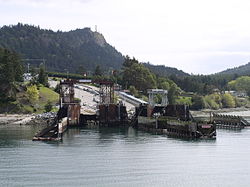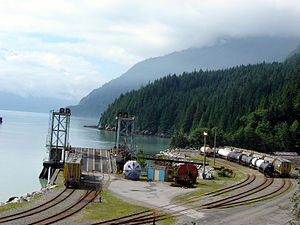Ferry slip


A ferry slip is a specialized
Often a ferry intended for motor vehicle transport will carry its own
In some parts of the world, the structures are also known as linkspans and transfer bridges.
Similar structures are used to receive barges, particularly if the barge is for the carriage of railcars.
San Francisco example
In the example shown below, a tugboat was positioned on the left side of the barge (our right in the apron view), pulling it with a stout rope called a springline. Nearly identical structures were used around San Francisco Bay. Unlike the electric motor drive used here and elsewhere, the Point Richmond ferry slip used water tanks as a portion of the counterweight, with the amount of water (provided by gravity from a local creek) regulated to move the apron up or down by admitting or draining water from the tanks.
 |
 |
Here, three tracks are provided for loading the barge. On the barge the three tracks are spread to allow clearance for the freight cars. The slip consists of pilings and guide boards to accurately position the barge relative to the apron. Once the barge is located properly, links are lowered from the apron to engage hooks on the barge, locking the linkspan and barge together.
While the apron shown could bear the weight of a locomotive, it could not withstand the traction, so a string of flatcars was used to link the locomotive to a short string of railcars, which were then moved on or off of the barge. If a locomotive was to be moved (a rare event), it would be moved by another locomotive using the same method. The auxiliary track to the left of the headworks was for storage of the flatcar string.
Historical significance of this example
This example, located in
San Francisco is no longer a significant port for freight as the mode of transport is now in
Facilities very similar to those pictured above were still in commercial operation as of 2007 in the
Gallery
-
Two track rail apron and Tinnsjø railway ferry SF Hydro
-
Automobile apron and ferry of the Lake Champlain Transportation Company
-
modern ferry slip at the Port of Dover
-
The only ferry slip in the history of Transport in Shanghai
See also
- Breakover angle
- Car float
- Drawbridge
- Ferry
- Ferry terminal
- Gantry crane
- Landing (water transport)
- Linkspan
- Movable bridges for a list of other movable bridge types
- New York Central Railroad 69th Street Transfer Bridge
- Port
- Roll-on/roll-off
- Slipway
- Train ferry





